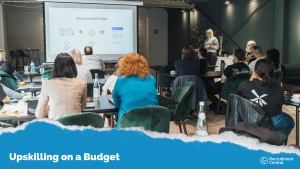Remote interviews have become a standard part of the hiring process in many industries. For some companies, they are the only way to connect with and assess a wide range of candidates.
The process works for everyone. No trains to catch, no meeting rooms to find, and more people can be brought into the process.
It’s still a different kind of conversation. Without a handshake or small talk on the way to the room, you lose a layer of connection. A slight delay in the audio can make an answer feel flat. Poor lighting can make you look less alert than you really are. You can’t read the panel in quite the same way when two of them are just profile pictures on a screen.
Strong remote interview skills bridge that gap. They help you prepare for both the questions and the format so you can use simple virtual interview tips to your advantage. Here are the skills candidates need to develop now.
Feeling nervous about all of this is normal. The goal isn’t to be perfect, it’s to be prepared enough that small glitches don’t throw you.
What You Will Learn in This Post
- How to master pre-interview technology setup, including testing platforms, optimising your internet connection, and configuring audio and video settings so technical issues don’t damage your first impression
- How to create a professional virtual environment, including positioning lighting correctly, choosing a distraction free background, and reducing noise so you appear polished on screen
- How to develop virtual communication skills, including maintaining camera eye contact, using body language effectively, and adjusting your voice to make up for the lack of in person presence
- How to prepare strategic interview content, including researching beyond company basics, developing relevant stories, and asking insightful questions that show genuine interest in how the role works remotely
- How to execute with confidence during the call, including starting well, giving clear, concise answers, engaging with multiple interviewers, and showing that you’re ready for remote work
- How to follow up professionally, including sending timely thank you messages, delivering promised materials quickly, and reflecting on your performance so your remote job interview preparation improves each time
Pre-Interview Technology Preparation
Plenty of virtual interviews start badly for reasons that have nothing to do with the candidate’s ability. The link doesn’t open. The sound is faint. The camera points at the ceiling. It’s not a great first impression, and it’s avoidable if you check things the day before.
Open the platform ahead of time. Not just to see if it launches, but to click through the settings as well. Zoom lets you sharpen the image and adjust the background. Microsoft Teams offers views that make it easier to see everyone in a single panel. Google Meet has captions built in, which can help if there’s a bit of echo on the line.
If you’re using software you’ve never tried before, make sure it works with your browser and give it access to your microphone and camera, so you’re not rushing through pop ups when the call starts.
Your internet connection is the backbone of the system. Shut down anything you don’t need running and keep your charger connected.
Sound quality is just as important as the picture. Even a basic wired headset can make a big difference. Test it with a real person, not just by talking to yourself on screen. This is a simple piece of video interview best practices that many people still skip.
Keep anything you might need, such as your resume, portfolio, or slides, saved on your device and available online. If you plan to glance at notes, be upfront about it. It’s better for the interviewer to know than to wonder why your eyes keep shifting away.
The Physical Environment and Professional Setup
The first thing most people notice in a virtual hiring process isn’t what you say, it’s how you look on screen. Not just your face, but the light, the colours, and the space around you. You don’t need anything fancy.
Face the light if you can. A window in front of you works best. If it’s behind you, you’ll be in shadow. If there’s no daylight, use a lamp. Keep it at about eye level so you don’t get shadows under your eyes. Overhead lights tend to make everyone look a bit washed out.
Before the day of the interview, open your camera and see what’s behind you. A plain wall is fine. A plant is fine. A messy kitchen isn’t. Neither is a pile of laundry. These things distract more than you think. If you try a virtual background, check that it doesn’t flicker around your hair when you move.
Noise can creep in as well. Close the windows if you live on a busy street. Let people in the house know what time you’ll be on the call. If there’s a chance of barking dogs or drilling next door, have another space in mind just in case.
Put what you might need, like your notes, a glass of water, or a pen and paper, where you can grab them without leaving the frame. That way you’re not disappearing mid answer.
Virtual Communication and Body Language Mastery
Research suggests that a large part of communication comes down to body language, but talking to a camera isn’t the same as speaking to a person face to face. You lose the quick glance when someone’s about to speak, the energy in the room, and the subtle shift when someone’s really engaged. That means the basics matter more.
Eye contact is one of them. Most people keep their eyes on the other person’s face on the monitor. That makes sense. From the interviewer’s side, though, it looks like you’re always looking just below them. Every so often, glance at the camera instead. It feels odd at first, but to them it feels like you’re talking straight to them.
Movement is another. Chairs that swivel make you look distracted without you realising. A hand tapping a pen sounds louder than you think. Even leaning too far back can give off the wrong signal. Sitting forward a bit, and staying still enough without being stiff, works better on screen than it does in a room.
Your voice has to carry more weight in this setting. Online, you don’t get the same support from body language, so slowing down slightly helps. Not so much that it sounds staged, just enough to make sure they catch everything, even if there’s a small delay.
Then there’s listening. On video, people can’t always tell if you’re following them unless you show it. A small nod. A quick “got it” or “that makes sense” when they pause. All of these things give your interviewer feedback that lets them know you’re listening.
Interview Content Preparation and Research
In a face to face setting, there’s small talk on the way to the meeting room, time to read the mood, and moments to settle in.
Remote interviews don’t give you that. One click and you’re there, straight into questions. If you haven’t done the homework, it shows quickly.
Look past the basics. Everyone reads the company’s “About” page. Go deeper. See what they’ve posted on LinkedIn in the last month. Skim their press releases. Even a quick look at employee profiles can show you how long people stay, or whether they’ve been hiring in your area. Those small details give you something to work with when you’re making conversation.
Think about how the role works in a remote setup. If they never see you in person, how will they know you’re reliable? If it’s hybrid, how do they expect you to split your time? These are topics you should be ready to talk about, not just for them, but for yourself.
Have a couple of stories ready. Talk about a time you solved something tricky. A time you worked with someone you’d never met face to face. Keep them short. People remember details.
If you’re asked about something technical, don’t just say you can do it. Show them. Have a file open, or a link ready, so you’re not scrambling mid call.
Ask your own questions as well. Try “What does a good first six months look like here” or “What’s the hardest part of the job that doesn’t show up in the description”. The answers will tell you more than anything in the job ad and help you stand out in online interviews.
During the Interview: Execution Excellence
The first minute matters more online than it does in person. There’s no handshake, no walk from reception, and no warm up chatter while someone pours coffee. You’re there, on screen, and they’re looking at you straight away.
Start steady with a simple “Good morning, thanks for making the time”, then let them set the pace. Be prepared for what you’ll do if the technology doesn’t work as planned. If something glitches, acknowledge it, and tell them what you’re going to try to fix the problem, such as refreshing your internet connection.
When you’re answering questions, be clear and concise. Long answers can feel even longer on video. If they want more detail, they’ll ask.
If there’s more than one interviewer, pay attention to who’s speaking, but make sure you look at the camera often enough that it feels like you’re speaking to all of them.
Finally, focus on showing everyone you can work well remotely without having to say the words. Answer clearly, respond quickly, and stay engaged even when they’re talking about something less exciting. Those small signs of focus show that you’ll show up the same way in the job.
Post-Interview Best Practices
Once you hang up, the room feels quiet. That’s normal. You start replaying parts of the conversation in your head, the answer you wish you’d tightened, and the one you think landed well. Leave it for a minute. Take a breath. Then get one last thing done.
Send a short thank you note while the conversation is still fresh. A quick message to say you appreciated their time, and a mention of one part of the discussion that stood out to you, is enough. If you said you’d send something, such as a work sample, a link, or a reference, do it straight away. It shows you follow through on your promises.
After that, you wait. If they gave you a timeline, trust it. If it slips, a gentle check in is fine, but don’t start sending daily emails. Before you move on completely, jot down what worked and what didn’t. A sentence or two is enough. You’ll be glad you did it when the next interview comes around. It turns a tough call into something you can actually learn from.
Making the Interview Work for You
Remote interviews aren’t going anywhere. For some roles, they’re the whole hiring process. For others, they’re the first gate you need to pass through before anyone meets you in person. Either way, they’re worth getting good at, and the right remote interview skills make the process far less stressful.
Most of it comes down to a few things, knowing your setup won’t let you down, showing up like the conversation matters, and giving the interviewer a clear sense of what it would be like to work with you day to day. None of that happens by accident. It’s in the preparation, the small details, and the way you carry yourself once the call starts.
If there’s one thing to keep in mind, it’s that the interview isn’t just about proving you can do the job. It’s about making it easy for them to picture you already doing it. Every choice you make before, during, and after the call should help with that.
Looking for extra support while navigating your job search?
Explore our Candidate Resources Hub for practical tools, templates, and career advice.
Refresh your materials with Updating Your Resume Made Easy, then stay motivated by subscribing for monthly insights, new roles, and job search tips here.
For more career and interview advice, visit this page.


















